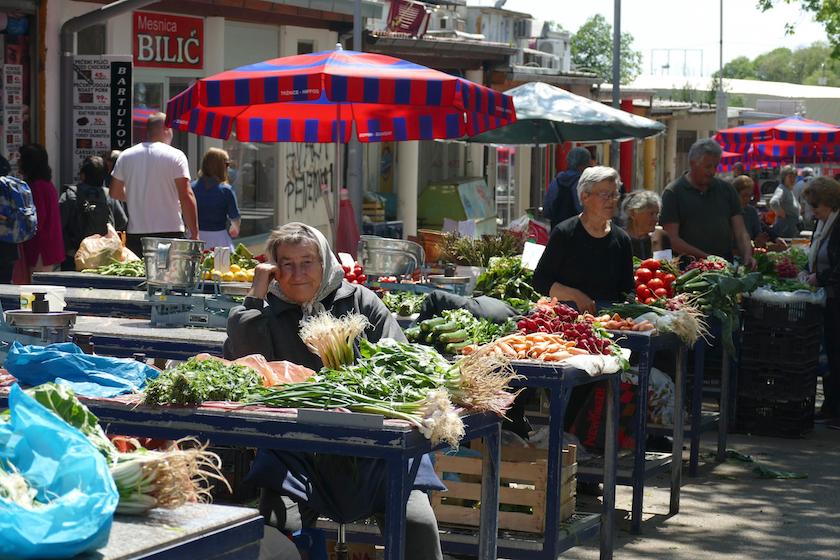Explore Croatia
Rovinj Istria
Rovinj, Istria in Croatia - Where the Hinterland Meets the Sea
Just on the border with Italy and Slovenia, in the northeast corner of the Adriatic Sea lays Istria: the westernmost coastal county of the Republic of Croatia. This is the place where the hinterland meets the sea, and it’s nestled on the crossroads of empires…a place that is both isolated and connected, like a “little continent” all of its own. Rovinj is a remarkable ancient fishing village with roots in the Bronze Age, and the old city started developing in the 3rd Century AD. Rovinj is surrounded by 22 islands and is an area of protected natural heritage.
The Istria Peninsula has been shaped through history and changing epochs that formed the social and cultural landscapes of the region: from the Greek and Roman empires, Venetian, Austro-Hungarian, French, and Italian rule, through to socialism and modern Croatia. It is often referred to as “Terra Magica”, or the magic land, which is apt for the heart-shaped peninsula where you can discover its legends, secrets, and beauty.
Rovinj History
According to archaeological findings, Rovinj and the surrounding area were inhabited in the prehistoric period (the Bronze and Iron Ages) when the culture of the Histrian tribe—who lived in Istria and traded with the Greeks and Etruscans—was at its peak. In fact, the most recent findings indicate that the island where contemporary Rovinj is located (a peninsula since 1763) was inhabited at the end of the 2nd and the beginning of the 1st millennium BC! The whole old city center is a living cultural monument. The art in Rovinj on the facades of the vibrant frescoes, museums, galleries, and city palaces reveals its history. Immerse yourself while exploring the cultural sights and walking through the town’s narrow streets or small squares. Starting with the medieval town walls and gates, you’ll pass under the Balbi’s Arch and wind along the picturesque Grisia Street. Rovinj’s city palace, the church of St. Euphemia, the Rovinj Heritage Museum, and the castle on St. Andrew’s Island should be on your must-see list!Interesting Historical Facts About Rovinj
- The tradition of tourism dates back to the late 19th century when Climate Resort Maria Theresa Seehospitz was opened in 1888. Children from across Austro-Hungary, Germany, Russia and other countries came here for treatment and rehabilitation.
- The town is officially bilingual: Croatian and Italian are the two languages you’re sure to run into.
- During the Roman Empire, the town was originally an island next to the coast. In the 1700s it became connected to the mainland and today the town looks like an egg-shaped peninsula jutting out of the land!
1. Town Walls and Gates
As early as in the 7th century, Rovinj was surrounded by city walls that were subsequently strengthened by towers. The city had seven gates, three of which have been preserved to this day: The Gate of St. Benedict, The Portica, and The Gate of the Holy Cross.
2. City Palace
The seat of the City mayor and the entire city administration! Once this was the Praetorian Palace, whose foundations date back to 1308. A prison could be found on the ground floor, while City Council Hall, offices, and a file room were on the upper floor. The front and the atrium were restored in 1850 and 1860 and in 1935 when the coats of arms were placed there representing Venetian and Rovinj families and the city.
3. Town Clock
This infamous tower is located in the main town square in Rovinj. It once represented the tower on the south corner of the former town walls. Built in the 17th century, the tower was extended several times. There once was a prison below the tower for minor offenders. The town clock—with its Venetian lion, the symbol of Serenissima dating back to the mid-19th century—was situated on the town gate fort near the Califfi Palace.
4. Grisia Street – Artists’ Mecca
Grisia Street is a beautiful street with cascading steps that leads up to the plateau of the parish church of St. Euphemia. It belongs to the most recognizable trademarks of the old town of Rovinj. The street is picturesquely cobbled with a winding stone staircase. It is unique for its one-day art competition exhibition, which has been organized in Grisia continuously since August 1967 by the Rovinj Heritage Museum.
The exhibition was created at the initiative of members of the Art Colony who aim to contribute to the spreading of visual arts and the revitalization of the town by gathering artists and displaying their works out in the open. A great number of artists display their works on Grisia attracting the attention of visitors and tourists.
5. The Church of St. Euphemia
The Church of St. Euphemia, often referred to as the Basilica of St. Euphemia (although it is not formally a basilica minor), is a Baroque church located in the heart of the historic part of Rovinj, Croatia. It dominates the whole old town center. This three-nave church was built from 1725 to 1736, over the remains of older, early Christian structures. Its dedication was originally to Saint George, and later to Saint George and Euphemia. Now the building is dedicated to Euphemia only.
Its façade dates from 1883. The relics of Saint Euphemia are preserved in a Roman sarcophagus from the sixth century (but adapted in the 15th century). The church contains several treasures and works of art: Gothic statues from the 15th century, paintings from the 16th and the 17th centuries: Last Supper and Christ in the Gethsemane. The bell tower resembles the tower of St Mark’s Basilica in Venice. On top of this 60 m-high tower stands the statue of Saint Euphemia, serving as a wind vane.
6. Castle on St. Andrew’s Island
This castle is, in fact, started as a Benedictine monastery founded in the 6th century. In the 15th century the Franciscans expanded and enlarged it. Baron Hütterott renovated it at the end of the 19th century. Today, the castle has been turned into a hotel and is decorated with works of the official painter of the Austro-Hungarian Navy, Alexander Kircher.
7. Batana House Eco Museum
A special treat is a visit to the Batana House Eco Museum dedicated to a wooden flatboat called batana. Due to its activity in preserving the flatboat-building tradition, the museum was included in the UNESCO’s Register of the world’s best practices for the safeguarding of intangible cultural heritage.
Golden Cape Forest Park
Among the most beautiful landscapes of western Istria is most assuredly the park ‘Zlatni rt’ which protects Rovinj and its harbor from the south and extends along the picturesque bays Lone and Škaraba, and Montauro and Punta Corrente capes. In 1890 the Trieste entrepreneur Georg Hütterott (Trieste, 1852 – 1910) bought plots in the bays Lone, and on Montravo and Punta Corrente capes, thus starting the slow transformation of that part of the landscape into a beautiful forest park. Georg Hütterott began the process of afforestation, which resulted in a forest rich in botanical species, as well as many tree-lined paths, promenades, trails, and meadows. Pine trees, cypresses, and laurel trees are the most common tree types in the park. Many exotic plants (such as the Lebanese cedar, Douglas fir, Ginkgo biloba, eucalyptus, etc.) were given to Georg Hütterott as a gift or were brought by him from his travels.
In front of the Punta Corrente Meadow, tall and beautiful Himalayan cedars are arranged in a six-pointed star. Hütterott must have had in his mind the uniqueness of parks of his time, especially the English landscape parks when he planted the trees in this singular figure. Furthermore, according to the brochure Klimatischer Kurort Cap Aureo bei Rovigno – Istrien. Ein Projekt published in 1908, Hütterott intended to transform ‘Cap Aureo’ and what he called the ‘coast of the sun’ into a health resort that was supposed to become one of the most important tourism destinations in this part of the world. Years of care, even after his death in 1910, have transformed this area into a unique and rich natural arboretum. It was designated a protected area in 1948, and a forest park in 1961, and still has that status today.
Rovinj Islands and the Coastal Area
These natural landscapes belong to the category of ‘landscapes of outstanding value’. One should not be surprised to learn this, as the indented coast, holm oak, Alpine and Bruce pine forests, and the special agricultural spaces amaze and capture by their beauty and level of preservation. This ‘landscape of outstanding value’ stretches from St. John’s Cape (Rt Sv. Ivana) to Barbariga and encompasses all twenty or so Rovinj islands and islets and the coastal area up to the distance of 500 m from the coastline. The St Andrew Island (Otok Sv. Andrija), occupying an area of 23 hectares, is the largest island of the Rovij archipelago and a true rarity in terms of vegetation. Botanists have recorded as many as 456 plant species there!
The Lim Bay
It is a protected landscape with slopes that are covered in different forms of evergreen shrubs, oak medunac, and bitter oak. This flora diversity on a relatively narrow area represents a unique phenomenon and has special ecological value. Romuald’s Cave is located nearby and can be reached by climbing through the 360-meter-long woods. The length of the cave is 105 meters. The average temperature in its interior is around 12 degrees and relative humidity is 70-75 per cent. The oldest remnants of the early humans in Istria were found in this cave. Along with the cave bear, cave lion, leopard, wolf, fox, brown bear, cave hyena, snow rabbit…a total of 41 animal species were found in the cave.
Palud Swamp
The brackish swamp in the south of the Rovinj region is a rich and diverse ecosystem of its own. It has fascinating flora, including several rare botanical species, ornithofauna, and water birds during the nesting, wintering, and migration periods. Until now, 220 bird species have been recorded. The area was designated an ornithological reserve in 2001.
The Fantazija Quarry
The quarry is located 1.5 km from Rovinj in the Monfiorenzo (toponym) area along the Rovinj-Bale road and is a unique example of limestone sedimentation in the world. Vertical and horizontal cross sections show layers of genetically different types of dolomite with preserved texture and digenetic and genetic characteristics. The rocks in this quarry are older than 130 million years and are used to provide a scientific explanation of similar rocks elsewhere.
Other Towns and Heritage Sites
Pula
The largest cultural and economic center of Istria with a rich itinerary of its 3000 years old history and one of the best preserved Roman amphitheaters in the world; Arena. Pula market built in the 19th century is a true construction miracle one must see. Below Pula is an underground tunnel world stretching almost across the entire Pula, known as Zerostrasse, erected as a shelter during WW1.
Labin & Rabac
Labin is the heritage highlight of eastern Istria, known for its numerous galleries and artists. In Rabac (which was once a small fishing place) you will find peace and quiet in the intact nature. Make sure to enjoy the beautiful trail of numerous brooks and rapids, crossed by seven bridges, connecting Labin with the seaside Rabac.
Small hilltop towns
The medieval Hum is known as the smallest town in the world, with less than 20 inhabitants. Motovun holds the best-preserved town walls in Istria. The International Motovun Film Festival is hosted here at the end of July where world-renowned film artists gather. Every summer in Grožnjan, the town transforms into a truly artistic beehive with summer music academies, artistic, dance, drama workshops, and peace activism workshops under the leadership of well-known expert teachers and famous names from music, art, and drama. Završje is a little picturesque town in Istria, which was one of the filming locations in 2017 for the film “Robin Hood.”
Brijuni National Park
An archipelago of 14 islands and islets in northwestern Istria. This national park is called “paradise on Earth” thanks to its rich flora and fauna, well-indented coast, and impressive history, dating all the way to the 3rd millennium BC. Before being established as a national park, Brijuni was Josip Broz Tito’s presidential home and welcomed many famous politicians, musicians, filmmakers, actors, and athletes. The national park still has that luxurious touch.
Top 5 Outdoor Activities
1. Hiking
There are plenty of hike options rewording in the scenery the trails pass through. One of the more strenuous is climbing to the peak of Istria, the “Učka Mountain.” The view from its highest peak, “Vojak,” extends beyond the visible encompassing of Istria, the islands of Kvarner, and even the Alpes and Venice.
2. Cycling and MTB
With the abundance of routes in Parenzana or bike park Rabac, Istria offers excellent cycling and MTB options for different levels of experience. They are combined with fantastic nature and plenty of small local agro-tourism for refueling after rides. A very popular “Istria Granfondo” is the international cycling marathon welcoming everyone in October 2021.
3. Caving
There are several amazing caves you can visit during your stay in Istria: Marble cave (Mramornica) with dusty red to white colored dripstones, The Kingdom of Feštini in the heart of Istria, Romuald’s Cave protected as the large bat habitat or The Baredine Pit, a protected geomorphological monument of nature.
4. Trail running
With plenty of trails throughout the peninsula, you will enjoy different sceneries, welcoming people and amazing trails. Trail running race “100 Miles of Istria: takes place in April 2021.
5. Truffle hunting
Join a local truffle hunter for this great experience in a way unique to Istria. Truffle-hunters search for precious truffles using specially-trained dogs that possess a very fine sense of smell. The hunter uses a special tool to extract truffles with the greatest care.
custom tours
Create the Croatian trip of your dreams!
what our guests say
Rovinj Croatia FAQs
Rovinj is perfect for sports and leisure activities, especially for spending time in the Golden Cape forest park. Visitors to Rovinj can engage in a variety of outdoor activities such as cycling on well-marked tracks, running, walking, and free climbing.
Istriot, a Romance language that was once widely spoken in this part of Istria is still spoken by some of the residents, but the town of Rovinj is officially bilingual: you’ll find Croatian and Italian.
Rovinj is small so can easily be navigated on foot. In fact, most of it is pedestrianized so you couldn’t drive even if you wanted to.
Did you know...
A special treat is a visit to the Batana House Eco Museum dedicated to a wooden flatboat called batana. Due to its activity in preserving the flatboat-building tradition, the museum was included in the UNESCO’s Register of the world’s best practices for the safeguarding of intangible cultural heritage.
Rovinj’s life started on what used to be the island of Mons Albanus. The first archeological traces of life date back to the Bronze Age, and the old city started developing in the 3rd century. At the beginning of the 18th century, the city started expanding outside the city walls to the mainland. The channel between the island and the mainland was filled with earth in 1763. And so, the old part of the city found itself on a peninsula. The old city bears witness to the times gone by and the diligence of local masters. The limited space conditioned the construction of narrow houses, narrow streets, and small squares. The characteristically built chimneys are a special feature of the old city as well. Thanks to the above-mentioned special features, the old city was proclaimed a monument of culture in 1963.
As early as the 7th century, Rovinj was surrounded by city walls that were subsequently strengthened by towers. The city had seven gates, three of which have been preserved to this day: The Gate of St. Benedict, The Portica and The Gate of the Holy Cross.
Grisia Street is a beautiful street with cascading steps that leads up to the plateau of the parish church of St. Euphemia. It belongs to the most recognizable trademarks of the old town of Rovinj. The street is picturesquely cobbled with a winding stone staircase. It is unique for its one-day art competition exhibition, which has been organized in Grisia continuously since August 1967 by the Rovinj Heritage Museum.
Related Blog Posts
Istria towns and sights not to be missed
The beauty and wonder of Istrias towns are made for postcards. Add these to your upcoming itinerary and youll be sure to have plenty to write home about:
Slow travel in Croatia – insider tips on how to travel better
Slow travel in Croatia- discovering authentic Croatia Dubrovnik, Hvar, Split, …












